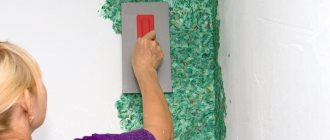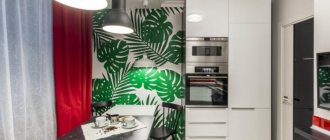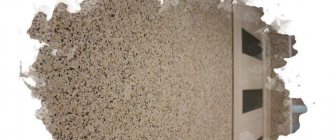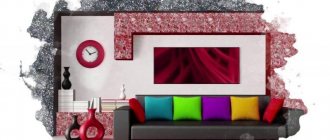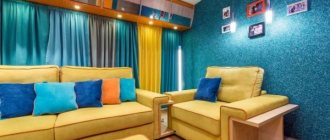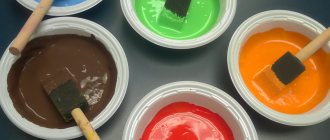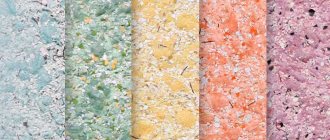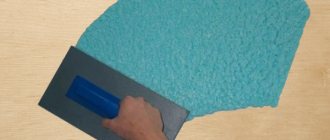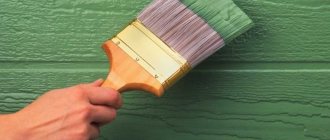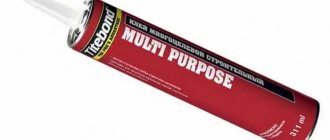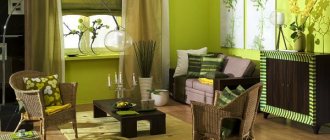0
13.12.2021
Liquid wallpaper, also known under the name “Danish plaster,” is rapidly gaining popularity. In principle, such material is considered self-sufficient. However, as a rule, during application, it is completely or partially tinted. In order to avoid mistakes when finishing walls and ceilings, you need to know whether liquid wallpaper can be painted and with what.
Danish plaster is considered a relatively new finishing material
Is it possible to paint liquid wallpaper?
Page navigation
During the use of Danish plaster, especially if small children and animals live in the apartment, the walls become dirty. As a result, stains, abrasions, stains form, in other words, there is a feeling of general dirtiness of the room. Therefore, over time, the need to update the interior arises.
If a major renovation is not included in your immediate plans, then painting the walls becomes an alternative option.
So, the answer to the question is whether it is possible to paint liquid wallpaper - yes. You can complete the task in the following ways:
- Using a spatula, remove liquid wallpaper from the wall, soak and tint, and then apply it again to the wall;
- apply paint to the wall using special tools and materials.
The main advantage of such a finishing material is the possibility of reuse.
Liquid wallpaper allows you to eliminate defects without performing repairs
Benefits of painting
Painting liquid wallpaper has undeniable advantages, due to which such finishing material is in high demand. These include:
- Painting makes it possible to disguise defects in the coating.
- You can remove and apply the composition to the walls many times without fear of harming the finishing coating.
- There is a wide range of colors and shades of paint on the market, which allows you to choose an option for any interior without unnecessary difficulties.
- Anyone can paint walls, even without experience.
- Danish plaster contains environmentally friendly components, which allows it to be used even for finishing work in children's rooms.
Wallpaper manufacturers are against painting their products on the wall. They argue this by saying that this type of finishing material can be removed many times, just to carry out work to change the color, and then reapplied to the wall.
Pros and cons of painting
Applying paint over wallpaper allows you to:
- update the interior quickly and at minimal cost;
- eliminate visible base defects;
- restore the interior design without removing the old coating;
- preserve the originality and texture of the main coating;
- create a layer that is not afraid of regular washing, including using household chemicals.
See also
How to repaint a kitchen facade with your own hands and select suitable compositions
Painting wallpaper is attractive because this procedure can be carried out repeatedly, without removing each time the already applied layer of finishing material.
Among the disadvantages of this method of interior restoration are the following:
- unique patterns are lost, since the paint hides the small details of the liquid wallpaper;
- tactile sensations change when touching the surface, as the material becomes harder and colder after painting;
- vapor permeability decreases.
When painting wallpaper, it is important to follow both the application technology and the manufacturers' recommendations. Otherwise, the treated base will begin to peel off. After painting the surface, it becomes impossible to carry out local repairs and eliminate minor defects without removing the liquid wallpaper. In addition, if there are grease stains on the wall, the procedure cannot be carried out.
Disadvantages of painting
Like any other finishing material, liquid wallpaper has its drawbacks:
- As a result of applying the coloring material, the surface structure itself changes. The material becomes monotonous and hard.
- The changes affect not only the original structure, but also the original colors.
- You can reuse liquid wallpaper only if paint has not been previously applied to the walls.
- This type of finishing is not suitable for rooms with high humidity levels, since the material has a high level of hygroscopicity.
- High price for quality materials.
For coloring, you should choose safe, environmentally friendly compounds
Selecting a finishing coating by price
Liquid wallpaper is an expensive finishing material. Their cost is influenced by 2 factors:
- brand awareness;
- share in % of silk fiber.
Type of finish and its price
Liquid wallpaper is sold in powder form. Packaged in 1 kg bags. One package of material on a flat surface is enough for 3-4 m2. On walls with defects, consumption increases.
The percentage of silk fiber affects the price of the decorative product:
- A 10 percent share of silk fiber is the “Economy” series, priced from 300 to 420 rubles;
- 50% silk fiber content - these are the “Relief” and “Prestige” series. Price from 500 to 600 rubles.;
- The 100 percent share of silk fiber is the collection material of the North, South, East, West and their “Silk Line” series. Price fluctuations from 1150 to 2000 rubles.
The proportion of fibers affects the texture of the coating layer, which increases material consumption.
Offers from manufacturers
Although there is not a large assortment of liquid wallpaper, you can choose.
| Brand | Manufacturer country | Description of material |
| Silk Plaster | Russia | Based on environmentally friendly raw materials. Assortment of materials by texture and shades. Collections are developed to suit different financial capabilities of the buyer. |
| Bioplast | Ukraine | Average finishing price. It's easy to work with, low consumption. |
| Leroy Marlene | France | High quality product. Due to its elasticity, the coating does not tear when new housing construction shrinks. The manufacturer takes care of creating collections for different price categories. |
| Poldecor | Poland | The collections combine high quality with low prices. |
| Silkcoat | Japan | The high price is confirmed by high quality. |
| Bayramix Koza | Türkiye | The manufacturer's proposals fall into the budget category. They have a long service life. |
| Senideco | France | The most expensive finish, but the high quality justifies this minus. |
| Like this | Russia | Finishing with such a brand is available to consumers with different financial capabilities. |
Choosing paint for painting
Liquid wallpaper is painted in two ways:
- The old coating is removed from the wall, soaked, color is added, and then applied to the surface again.
- Conventional painting, that is, applying a layer of paint using improvised means and tools.
Construction stores offer several types of painting compositions.
To make the right choice, before purchasing, you need to study the features of each paint option for liquid wallpaper.
Water-based paints
This option is considered the most affordable because its cost is not so high. Such compositions are a solution that, as a result of interaction with water, acquires various pigments and polymers.
Unfortunately, water-based emulsion has a significant drawback. The fact is that after painting, a film forms on the canvas, as a result of which the so-called “breathing walls” effect is eliminated.
The main advantage of water-based paint is that it dries quickly on the surface.
The high price of Danish plaster is justified by its characteristics
Acrylic paints
When applied, acrylates form a durable film that is resistant to mechanical damage.
Acrylic paints are reliable and durable, but they have the disadvantage that the composition takes a long time to dry.
Acrylic compositions are resistant to moisture, so the wallpaper tolerates wet cleaning well.
Latex paints
Latex paints are easy to apply to the surface and are also highly water-repellent. They are distinguished by mechanical strength and environmental safety, so they are well suited for children's rooms, kitchens and bathrooms, that is, for “problem” rooms.
But, despite all the advantages, latex paints have a significant drawback - in the absence of good ventilation, mold forms on the coating.
Since liquid wallpaper is not intended for use in rooms with high humidity, latex is usually applied to them only locally.
Silicone paints
Silicone paints are considered the best choice for painting liquid wallpaper, as it creates a “breathable” film that does not crack and does not fade in the sun.
But, unfortunately, the purchase of such compounds is far from cheap, so not everyone can afford it.
Silicone paints are considered the best composition for working with liquid wallpaper.
Where, how much and how much?
In general, for some reason our stores neglect such a thing as liquid wallpaper. It often happened like this: there are samples lying around, but the material itself is not there, and is not in sight. We found a selection of wallpapers on the market from the Chinese, made in China, and there – Russian liquid wallpaper “That’s So”.
We bought both because the color scheme was very similar, except that the Chinese ones had shiny, golden shavings that promised our walls a beautiful shimmer in the sun.
The plan was simple. Apply one in one room, and another in another. The price of wallpaper is about 450 rubles. per kilogram package, which is enough for 5 square meters of surface, despite the fact that the wallpaper is laid with a thickness of 1 - 2 mm.
The conclusion is this: if you are interested in such material, then you should look for it not only in large stores, but also in construction markets or on the Internet.
Materials and tools
To perform surface painting work, you will need to acquire the following materials and tools:
- paint;
- spray or roller;
- an extension for the roller handle or a stepladder;
- small malar bone;
- slotted or Phillips screwdriver;
- capacity if you plan to use a roller;
- floor covering that will protect against paint splashes;
- masking tape.
Danish plaster is presented in a huge color palette, so choosing a color that suits a specific interior will not be difficult
Preparatory work
The procedure for carrying out preparatory work:
- Before carrying out painting work, first of all, all obstacles are removed, so trims, sockets, switches are removed from all doors and baseboards and moldings are dismantled.
- Gypsum putty is applied to the damaged surfaces, but it is not smoothed, maintaining the roughness of the canvas.
- Oil stains are removed using alcohol or acetone for this purpose.
- After drying, the walls are treated with a primer.
In construction stores, Danish plaster is sold in bags with instructions for use attached.
To make the interior original, you can consider the option of applying drawings to the walls using a stencil.
How to paint liquid wallpaper
After the preparatory work has been completed, you can begin the process of painting liquid wallpaper. It is better to perform it using a roller with a fur attachment and a brush. Walls should be painted from top to bottom, removing streaks before they have time to dry.
So, the role of the primer is played by the layer that is applied very first. Therefore, a small amount of paint must be diluted with water (10:1).
First of all, you should paint the corners of the room and the edges of the wallpaper. To complete the task you will need to use a round and small roller or brush. To prevent paint from falling onto inconvenient areas during the painting process, you will need a spatula that will serve as a so-called barrier.
The next step is to apply paint to the entire surface of the wallpaper. Painting must be done in several layers.
After painting the walls is completed, you should begin finishing the ceiling, if necessary. To do this, you will need to install a high stepladder and, as in the case of walls, apply the composition.
If all stains are not eliminated immediately, it will be almost impossible to get rid of them after painting.
Often, the method of not complete, but partial painting is used, when it is necessary to mask imperfections and update the area. It is carried out, as a rule, in places where the wallpaper comes into contact with furniture or, in cases where decorative painting is planned.
When performing work, it is necessary to protect the floor from paint.
Instructions for painting liquid wallpaper
To work, you will need a fur roller, possibly with a stick, and a painting tray. You can use a paint sprayer if you have one. Brushes and foam rollers are not suitable. The pile on the roller should be of medium length, because... A “short-haired” tool will not allow you to completely paint over a rough surface, and a long hair will create too many splashes. You may need a stepladder for working at height, plus masking tape to protect mating surfaces. The floor is covered with film or covered with old newspapers. For convenience, it is better to remove all switches, sockets, moldings, baseboards with trim. Or cover them with masking tape. Further preparatory work includes cleaning surfaces from dust and coarse dirt. Oil stains are wiped with a rag soaked in an alcohol solution (you can use vodka or acetone). Areas heavily saturated with fat are removed. If there are noticeable mechanical damages, they are repaired with putty or local application of liquid wallpaper. To do this, take gypsum or acrylic putty, then do not smooth it, but, on the contrary, make it rough, bringing the texture as close as possible to the surrounding one. The next mandatory stage of preparation is priming 1-3 days before painting. This will reduce paint absorption by the fibrous substrate, bind remaining dust, and also improve adhesion. You need to wait until the primer dries completely.
Fur roller
Paint tray
Sprayer Pay attention to: What to choose: painting or wallpaper
How to paint liquid wallpaper?
To preserve the texture of liquid wallpaper, it is better to dilute the paint and use it in a more liquid form. The most difficult places are processed first - in the corners, at the border with the floor, ceiling, furniture. Most often they use a wide brush there. Usually the paint is applied in several layers. Each new layer is after the previous one has dried, i.e. no less than 2 hours later. This is with ideal ventilation and room temperature. Application technology – bottom up. All drips and drips are immediately rubbed off.
Features of applying patterns and drawings
The application of patterns and drawings is carried out after the first layer of paint on the walls has dried. To make the surface varied, stencils are used. They can be made with your own hands or purchased ready-made in construction stores, where they are presented in a wide range.
To make stencils, you need to purchase thick cardboard. Next, using a sharp knife, eliminate those areas where paint is planned to be applied. The stencil itself is applied to the liquid wallpaper and then the pattern is rolled over with a roller.
Applying patterns and drawings is a complex process and it is hardly possible to complete it without outside help, so you will need the additional “hand” of a friend. But this will make the interior of the room stylish and original.
Among finishing materials, Danish plaster occupies a leading position, since progressive wallpaper is used for its production. In addition, they fully meet all consumer needs.
